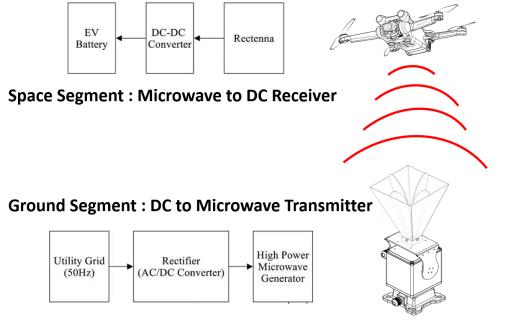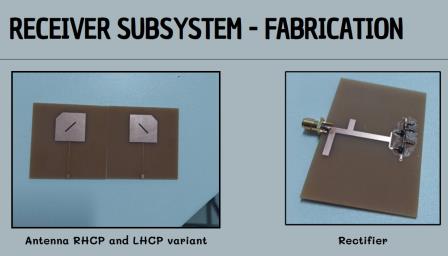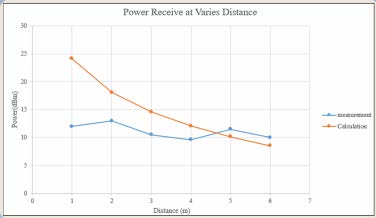Dr.Joko Suryana
STE-ITB
Abstract
Unmanned Aerial Vehicles (UAVs) are indispensable in modern applications ranging from surveillance to delivery and disaster management. However, their operational potential is often constrained by limited battery capacity, requiring frequent landings for recharging.
This research addresses these challenges by developing an “on the air” wireless charging system using microwave power transfer technology using 2.45 GHz frequency operation. The system leverages highly efficient microwave energy transmission to provide mid-air charging, enabling continuous operation without the need for landing. A robust prototype system consisting of high-power microwave transmitters and lightweight, efficient receivers onboard UAVs is proposed. Testing and optimization focus on critical parameters such as charging efficiency, transmission stability over varying distances, and environmental resilience.
Results demonstrate a system efficiency exceeding 91% within a 4-meter range, with high tolerance to misalignment and adverse weather conditions. This innovation redefines UAV operational capabilities, offering transformative solutions for persistent applications across sectors.
Keyword: Drone Charging, Wireless Power Transmission, Microwave Technology
Introduction
Unmanned Aerial Vehicles (UAVs) have transformed numerous industries, including logistics, agriculture, surveillance, and search and rescue. Despite their potential, limited flight time due to battery constraints remains a critical bottleneck. Traditional solutions such as battery swapping and contact-based charging face inherent limitations, including downtime, precision requirements, and exposure to environmental risks.
Wireless Power Transfer (WPT) using Microwave Power Transmission presents a novel and transformative approach to this challenge. Unlike inductive or capacitive coupling, which require proximity and precise alignment, microwave-based WPT enables mid-range energy transmission with minimal losses. The “on the air” wireless charging system proposed in this research aims to extend UAV operational endurance by enabling in-flight charging, eliminating downtime, and enhancing reliability even in extreme conditions.

Research Method
The wireless charging system for Unmanned Aerial Vehicles (UAVs) is divided into two main segments: the aerial segment (UAV) and the ground segment (high-power microwave transmitter), as illustrated in Figure 1. The UAV is equipped with a wireless charging receiver that captures microwave energy transmitted from the ground-based charging station. This energy transfer is achieved via microwave waves with 2.45 GHz Magnetron combined with Quad Ridged Horn antenna , which are converted into electrical power to charge the UAV’s battery. The high-power microwave transmitter ensures efficient energy transfer over significant distances, facilitating charging without the need for physical connectors. This approach extends UAV flight durations and enhances operational flexibility by eliminating the need for direct contact during charging.
The circuit design process involves the development of a prototype electronic structure, which includes the selection of the optimal microwave frequency, the design of the communication interface, and the careful selection of electronic components. The design phase emphasizes the need for efficient and reliable wireless power delivery while maintaining safety and environmental resilience. Special attention is given to ensuring the system operates under varying environmental conditions without compromising its performance, thus providing a robust solution for UAV charging in dynamic operational scenarios as illustrated in Figure 2.


Discussion & Result
The strongest signal reception occurs at a distance of 2 meters, measuring 7.050397 dBm. At farther distances, such as 5 and 6 meters, the received power decreases, indicating signal attenuation with increasing distance as in Figure 3 (top). Power measured at distances of 1-4 meters shows irregular results, likely due to measurements in the near-field area. The near field is dominated by reactive components (electric and magnetic fields that store energy rather than radiate it).


Therefore, more accurate measurements are conducted in the far-field area, where the electromagnetic field has fully transitioned into traveling waves, and signal intensity decreases predictably according to the inverse square law.
Additionally, power measurements are conducted within the [-90°,90°] angle from the main radiation pattern at a distance of 5m. The measurement results are shown in the graph as Figure 3 (bottom).
The unloaded output voltage measurement shows the circuit being able to provide up to 14,7 V at 26 dBm input power. Adding another rectifying circuit in series increases the voltage output as if the input power doubled if only one circuit is used. A single circuit can supply the voltage necessary to turn on all the LEDs, albeit at a low current of 1,54 mA. This test proves that the circuit is theoretically able to charge a battery if its output voltage is adjusted to 8,5 V.
Conclusion
In this project, a Microwave-Based Wireless Power Transmission (WPT) system has been developed to enhance the operational capabilities of Unmanned Aerial Vehicles (UAVs) in emergency situations. The development of this system involves various components, including a Radio Frequency (RF) power generator for generating RF waves and an antenna component for directing transmission power. The magnetron is used as part of the RF power generator to generate microwave waves with an output power of up to 945W.
Subsequently, measurements were conducted to test the performance of the developed system. From the measurement results, optimal antenna parameters have been obtained, such as S11 values below -10, VSWR approaching 1, and a gain of 17.32 dB. The radiation pattern provided is boresight. From the RF power generator measurement, an output power of 820.3515 Watts was obtained, and when using the antenna (integrated system), an output power of 4197.5898 dB was obtained.
The proposed WPT receiver can provide up to 22,9 V when tested with a magnetron-based transmitter at 4 m distance, and light up 5 LEDs in series with 8,6 V forward voltage, which is enough voltage to charge a battery. However, for enhancing the efficiency and the overall output power we can still increase by adding the rectenna arrays.